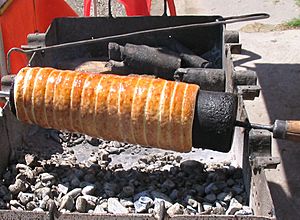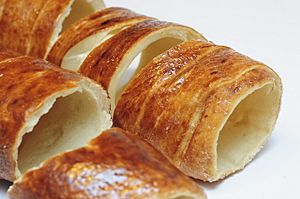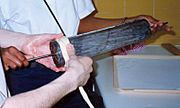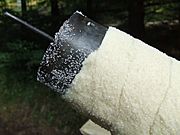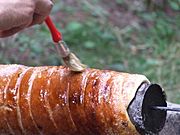- This page was last modified on 17 October 2025, at 10:18. Suggest an edit.
Kürtőskalács facts for kids
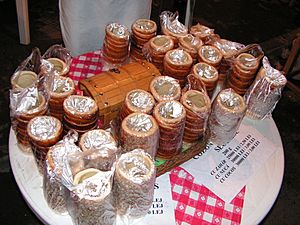
Varieties of kürtőskalács
|
|
| Region or state | Székelyland |
|---|---|
| Main ingredients | Flour, sugar, milk, butter, eggs, yeast, salt |
Kürtőskalács is a special spit cake from Transylvania. It is popular with Hungarians, especially the Székelys. This sweet treat was first mentioned in writing in 1679. The first recipe for it appeared in a cookbook in 1781.
Kürtőskalács is made from sweet, soft dough with yeast. A long strip of dough is wrapped around a cone-shaped baking spit. Then, it is rolled in granulated sugar. The cake is roasted over charcoal and brushed with melted butter. It cooks until it turns a golden-brown color. As it bakes, the sugar on the outside melts and turns into a shiny, crispy crust. You can also add toppings like ground walnuts or powdered cinnamon to the cake.
Contents
What's in a Name?
The name Kürtőskalács comes from the Hungarian word kürtő, which means "stovepipe" or "chimney". This is because the fresh, warm cake looks like a hot chimney when it comes off the spit.
A scholar named Attila T. Szabó from Cluj-Napoca agrees with this idea. He said that when the cake is taken off the spit, it looks like a 25 to 30 centimeter long tube. Because it is served in this tube shape, people started calling it by a name that describes its chimney-like look.
Over the years, people used different names for this cake. Some old names included dorongfánk (spit-donut) or botratekercs (stick roll). The name "kürtőskalács" became widely used in the middle of the 20th century. It was first printed in a cookbook in 1926.
People are trying to get Kürtőskalács recognized by the European Union. This would protect its name and origin, like how Champagne is protected.
A Look Back in Time
The idea of cakes baked on a rotating spit goes back to the Middle Ages, around 1450. A old book from Heidelberg describes a strip of dough wound around a spit. It was brushed with egg yolk before baking.
Over time, these spit cakes developed into different types. Kürtőskalács is one of them. Other similar cakes include Skalicky trdelnik from Slovakia and Baumstriezel from Transylvanian Saxons.
The first known recipe for Kürtőskalács is from Transylvania in 1784. It was in Countess Mária Mikes's cookbook. This early recipe did not mention adding any sugar. A recipe from 1795 was the first to suggest adding sugar after baking.
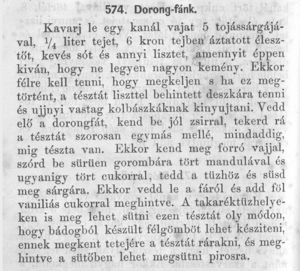
Excerpt from Rézi néni Szakácskönyve (Aunt Rézi's Cookbook), published in Szeged in 1876, with the first recipe that applies sprinkling sugar on kürtőskalács before baking to achieve a caramelized sugar glaze
About 100 years later, in 1876, a new step in making Kürtőskalács appeared. This was the idea of a caramelized sugar glaze. Aunt Rézi’s Cookbook suggested sprinkling sugar on the dough before baking. The heat would melt the sugar, creating a sweet, continuous glaze. Later, people started using pure sugar instead of almond sugar.
The idea of adding toppings like ground walnuts came much later, in the late 20th century. Cookbooks from the 1980s started suggesting this. Today, you can find many toppings like cinnamon, coconut, and cocoa.
The most common way to make Kürtőskalács today developed in Szeklerland in the early 1900s. This method involves rolling the dough on a flat surface with granulated sugar. This presses the dough layers together, making the cake smoother and more compact. The first written record of this technique was in a cookbook published between 1934 and 1943.
How it Became Popular
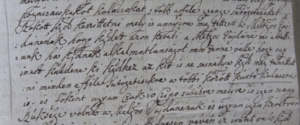
Excerpt from a letter of Mrs. Feratti, née Ágnes Kálnoki (Iași, 1723), in which is the first mention of the term kürtő kaláts, i.e. kürtőskalács. The original letter can be found in the Cluj State Archive.
Kürtőskalács became popular among Hungarian noble families in the early 1700s. There's a letter from a mother superior in Moldavia asking a noblewoman, Mrs. Péter Apor, to teach her butler how to bake Kürtőskalács. This shows how special the cake was.
By the end of the 1700s, Kürtőskalács was well-known in all Hungarian-speaking areas. It was a key part of both city and country cooking. In 1868, Balázs Orbán wrote about a legend from Udvarhelyszék. It said that the Szeklers, trapped by the Tatars, made a huge Kürtőskalács out of straw. They showed it to the enemy to make them think they had plenty of food, and the Tatars left.
In the early 1900s, as cities grew, newer cakes became popular. But in the Szeklerland, where open fireplaces were still common, Kürtőskalács remained a strong tradition. Even today, Kürtőskalács baked over coals is a must-have at Transylvanian weddings.
After the Revolutions of 1989, Kürtőskalács became a popular treat for tourists visiting Szekler villages. It helped show off the culture of Szeklerland and Transylvania to the world. Now, because of travel and tourism, Kürtőskalács is seen as a symbol of European food, not just Hungarian or Szekler.
Different Types of Kürtőskalács
There are three main types of Kürtőskalács, but they are all made in a similar way.
The traditional, homemade version became standard in the early 1900s. It uses specific ingredients: sugar, wheat flour, butter, milk, eggs, yeast, and salt. Toppings are usually limited to ground walnuts, almonds, cinnamon, or vanilla sugar.
Carnival versions became popular in the late 1900s. These are cheaper to make and can be sold from small, mobile stands. They might use vegetable oil instead of butter, or milk powder instead of fresh milk. Eggs can also be replaced or left out. These versions can have many different toppings for flavor and smell.
Newer alternative versions appeared in the early 2000s. These can be even more flexible. The dough might be made from non-wheat flour. The inside of the cake can also have a coating, or it can include fruit pieces. You can even find gluten-free or vegan (without animal products) Kürtőskalács.
Kürtősfánk is a similar cake. It is fried in oil or fat and topped with sugar after baking. Sometimes it is filled with whipped cream.
How it's Baked
Kürtőskalács is made from a firm, dry yeast dough. A "twine" of dough is wrapped around a spit. Then, the spit with the dough is rolled in sugar. Before or during baking, it is brushed with melted butter. The cake is ready when it has a nice, brownish-red color all over.
Traditional homemade Kürtőskalács must use only natural ingredients. For other versions, some ingredients like margarine or vanilla sugar powder can be synthetic.
You can add more flavors to Kürtőskalács with a final topping. Any sweet topping can be used, as long as it doesn't contain salt, cheese, meat, or other non-dessert ingredients.
Other cakes similar to Kürtőskalács include the Baumstriezel from Transylvanian Saxons. It has a cylinder shape, not a spiral. Skalicky Trdelnik from Slovakia and Trdlo from the Czech Republic are also similar. But they don't have the caramelized sugar glaze that Kürtőskalács has.
Names in Other Languages
Countries near Hungary have their own names for this cake. The Saxons in Transylvania called it Schornsteinkuchen, which means "chimney cake". Poles and Romanians use names that sound like "Kürtőskalács" or translate to "Hungarian cake" or "Szekler cake". For example, Romanians call it Colac Secuiesc or Cozonac Secuiesc. Other names might use "Kurtosh" for kürtős and "cake" for kalács.
See also
 In Spanish: Kürtőskalács para niños
In Spanish: Kürtőskalács para niños

